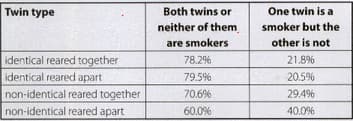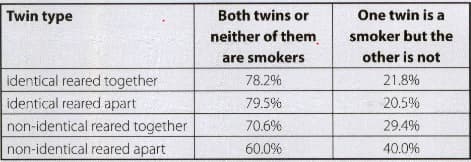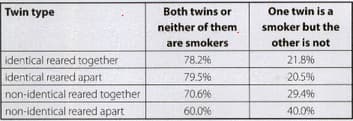Some chemicals in cigarette smoke react with the bases in DNA. Errors are then made when the DNA is copied, so DNA is produced with an altered base sequence. What is a likely consequence of this?

Important Questions on Genes
The Swedish Twin Register collected data on smoking behaviour for identical twins and non-identical twins who had been reared in the same or different families. Data for twin boys are shown in the table.

From the above table we can conclude that identical twins show similar behaviour in their smoking behaviour. What conclusion we can draw from this?
The Swedish Twin Register collected data on smoking behaviour for identical twins and non-identical twins who had been reared in the same or different families. Data for twin boys are shown in the table.

Which are more similar in their smoking behaviour-twins reared together or twins reared apart?
The Swedish Twin Register collected data on smoking behaviour for identical twins and non-identical twins who had been reared in the same or different families. Data for twin boys are shown in the table.

From the above table, we can conclude non-identical twins reared together are similar to smoking behaviour. What conclusion we can draw from this?
Smoking increases the risk of at least 17 classes of cancer. It is easy to understand how smoking could cause lung cancer, but less obvious how bladder cancer could be a consequence of smoking.
Research the link between smoking and bladder cancer. Identity each stage in the process from smoke inhalation to a tumour developing in the bladder.
How does smoking cause bladder cancer? Write a concise answer to this question using scientific language effectively.
